The various species of macaws are the largest companion birds in the world. Not only can they weigh several pounds (that’s a big deal since many parrots are usually weighed in grams) but their long tails and massive wing spans really means they require a lot of space just to be able to comfortably turn around. Plus, their massive beaks require cage bars and toys that can withstand their strong bite strength.
So how do you provide a suitable cage for large birds like blue and golds, scarlets, green-wings, and even hyacinths? It’s one of many challenges facing macaw owners.
See how John provides an enriching environment for his blue & gold macaw.
Large Blue and Gold Macaw Cage
Meet John’s blue & gold macaw named Harmony.
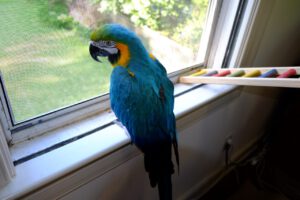
John says, “I live in an older house and the rooms are smaller than newer construction. The largest cage I could provide is a 30″ x 40”, which is the minimum cage size for a bird this size. My solution is to provide an expanded environment that includes Java trees, ladders, atoms and other perches that allow her to move around freely. The door to the cage is never closed, so she can easily move between her cage and her Java tree perch.”
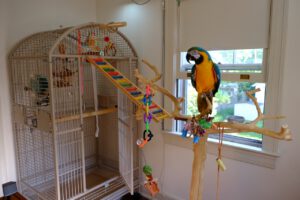
Because John recognizes that Harmony needs more room than her cage can provide, he created an environment in his home office that provides plenty of space, freedom and enrichment opportunities.
Keeping the Area Clean
Big birds make big messes. John solved the cleaning problem by laying down vinyl flooring in key areas of the office/birdroom. He got his at Home Depot. He made sure to roll out the flooring in a different part of the house for more than a week, to allow it to “off gas” that new vinyl smell.
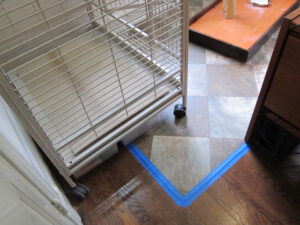
John has other tricks for making clean up easier.
He now uses big rolls of craft paper, rather than newspaper to catch the macaw-sized messes. The roll is kept on a spindle under his desk, but it’s still easy to roll out fresh paper daily. A roll is 720 feet by 24″ and last him (and Harmony) about two months.

Parrot Toys and Activities
Favorite daily activities include window time, where pellets, milk thistle seeds, and other treats are taken. She spends about an hour in this front, street window every day. She says “hello” and “goodbye” to the people passing below, who have come to know her and talk back to her. The window sill and the radiator cover below it catch the mess. Window time requires that you are present to ensure safety, and the window screen needs to be in good condition. (Keep in mind that all birds behave differently, so you will need to observe your parrot to make sure it doesn’t chew through window coverings or get anxious about what it sees outside.)
John reports that Harmony doesn’t like many of the large toys designed specifically for macaws. Part of that may be how they fit in her (relatively) small cage.
The photo below shows some of her favorite in-cage toys: a roll of adding machine tape, a plastic ball and bell, and a large birdie bagel on her high perch. When hanging toys, John avoids the pear-shaped quick links as they are too weak to survive powerful beaks. He uses heavier oval-shaped links and checks them periodically to make sure they haven’t come undone.


Shredding and foraging toys are important and provide entertainment as well as food. The skewer holds a section of dried corn (a favorite) as well as a vine ball and other shreddable items. Bells are attached to almost everything to add an element of reaction to the toys.
Bells given to Macaws must be strong and durable to be safe. Do not use small, fragile bells intended for smaller birds!
This blue & gold macaw also loves her plastic toy box that holds a variety of things for her to investigate and throw on the bottom of the cage. Old bits of toys are a good addition to the toy box. She frequently empties the box at the end of the day.
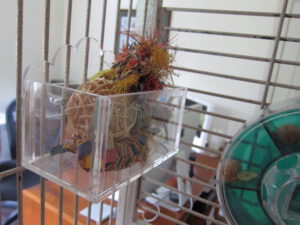
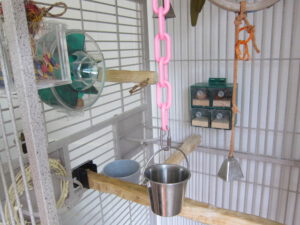
The second photo shows a foraging wheel on the left and a set of foraging drawers on the right and a stainless steel bucket. The wheel is periodically switched out and exchanged with another different foraging toy. The foraging toys are packed with treats and she has to manipulate the toy to extract the item she wants. Treats are also placed in the bucket and are picked out either from the lower perch or by pulling up the bucket from the upper perch.
Large Parrot Perches
Perches for large birds are something of a problem because of the span of the cage. It is not possible to find natural perches longer than about 32” or so, and the wide dimensions of the cage exceed that.
John has a lot to say about making his own macaw-appropriate perches:
“Many people use 2 x 4 lumber mounted vertically (white lumber only, not pressure treated ever) but that has several downsides.
First, the shape is not good. Two by fours are too tall for the bird to grasp around the perch, making the bird rest on top of the perch without having a proper grip.
Second, a 2 x 4 suffers from the same serious shortcoming of a dowel perch: it has a smooth continuous form and does not provide the naturally irregular surface needed for good foot health.
Modern basic-grade 2 x 4 material is fast growth, soft material, and is milled with slightly rounded edges. The round edges mean that despite the drawbacks they can be used without modification, hopefully for short periods of time. The better choice is to use a 2 x 2 instead of a 2 x 4, which will allow the bird to grasp the perch properly.
But the catch is that this lumber size is typically of a significantly better grade, intended for finish work, and is not made with rounded edges. The edges are in fact quite sharp and must be rounded off before the piece can be used as a perch.
Once it’s rounded off, you would have a squarish dowel, which is still not what we really want. So the final step is to heavily shape the piece to mimic the irregular form of a natural perch.
This is what I have done for the longer perches in the cage. The work was done with an assortment of power tools that I realize are not available to most people, but this approach has provided a good solution and if someone is handy and has the tools they can make a most satisfactory perch this way.
Check out these photos of John’s DIY perches!
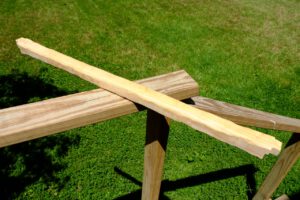
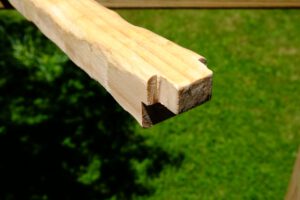
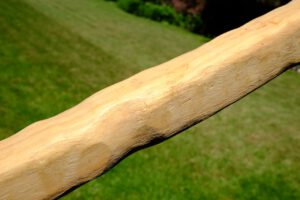
You can see how John’s DIY perches fit into the cage in the photo in the previous section.
The Birdie Play Area
But wait, of course, there’s more!
Harmony has a separate play area away from her cage. There is a cargo net, a very big Atom swing (the round ball perch suspended from the ceiling), and another Java tree. They are close enough to each other to allow this lucky macaw to easily move around between them when she wants.

John says, “The only problem with this play area is that she does not want to leave it, frequently staying until it gets dark outside and she finally decides that she wants to return to her cage area for the night.”
– – – – – –
A HUGE thanks to John for sharing photos and details of Harmony’s cage, perches, toys and general setup. We appreciate the care and thought that has gone into making his macaw’s environment fun and enriching, as well as the time he’s taken to help other macaw owners learn how they can do the same.
So, what do you think? Does your macaw cage setup rival John’s or are there ideas you want to steal for your own large parrot? Let us know in the comments.